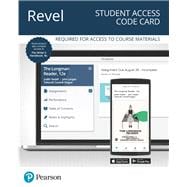For courses in first-year composition.
The acclaimed rhetorical modes reader with detailed writing guidance
Revel™ The Longman Reader combines celebrated pedagogy with a wealth of readings to help students develop sound writing skills. The opening chapters focus on reading critically and the writing process, while subsequent chapters provide detailed writing instruction. To demonstrate various developmental patterns, the text presents professional essays ranging in approach and subject matter — from the humorous to the informative, and from personal meditation to argument. The 12th Edition includes 23 new professional selections, a new, predominantly visual composition, and additional coverage of how to critically assess both words and images.
Revel is Pearson’s newest way of delivering our respected content. Fully digital and highly engaging, Revel replaces the textbook and gives students everything they need for the course. Informed by extensive research on how people read, think, and learn, Revel is an interactive learning environment that enables students to read, practice, and study in one continuous experience — for less than the cost of a traditional textbook.
This product is a part of the Revel Plus One program and includes access to Nadell/Langan/Coxwell-Teague, The Longman Reader and Faigley, The Writer’s Handbook within a single Revel course.
NOTE: Revel is a fully digital delivery of Pearson content. This ISBN is for the standalone Revel access card. In addition to this access card, you will need a course invite link, provided by your instructor, to register for and use Revel.











